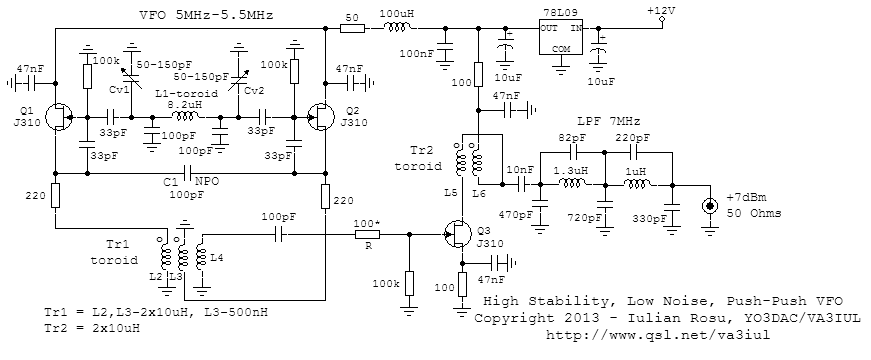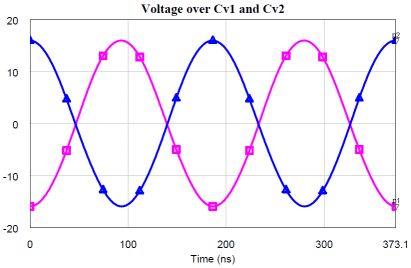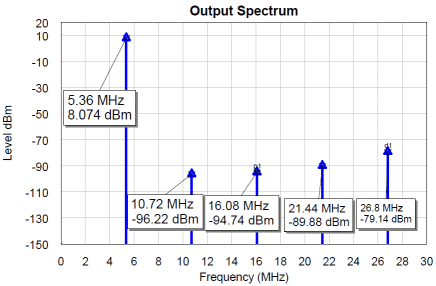
High Stability, Low Noise, Push-Push VFO
pdf version Iulian Rosu, YO3DAC / VA3IUL, http://www.qsl.net/va3iul/

When is about frequency stability, building a VFO (Variable Frequency Oscillator) most of the time we live to the mercy of the quality factor of the components. Looks strange, but today the Q-factor of inductors and capacitors used in the industry is going down, due to high requirements on their miniaturization. For example an air core inductor from a tube receiver built 70 years ago can have a Q-factor a hundred times greater than an SMD inductor from a receiver of a cellular phone.
With the Push-Push VFO circuit presented I was thinking to an oscillator that gives good frequency stability, mainly by its design topology, and secondary by the quality factor of the components used.
The Push-Push oscillator concept was introduced in 1956 by Larson E. Rapp, W1OU, one of the greatest visionaries in radio design at that time.
Initially the symmetrical Push-Push oscillators were developed to use their behaviour of cancelling the fundamental frequency fo and getting high 2nd harmonic (2fo) at the output.
The two active devices (Q1 and Q2) of the symmetrical topology
are operating in 180° anti-phase (odd mode) at the fundamental frequency.
In this way using the circuit symmetry, you can generate stable frequencies
twice higher than the resonant frequency of the resonator, without using a
filter at the output.
In the same time a Push-Push oscillator could be designed to operate
at both, the fundamental frequency fo and the 2nd
harmonic frequency 2fo. In this situation if you feed fo
into a frequency divider instead of 2fo lowers the
divider efforts.
Third
option, depending by the output coupling topology you chose, the Push-Push
oscillator can operate only at fundamental frequency fo, which
is the topology used in the VFO circuit presented here.
In general, the Push-Push concept offers several advantages over single-ended
designs:
In PushPush oscillators a high Loaded-Q can be achieved (close
to unloaded-Q) using practical element values. This happen because each active
element is acting as a "Q-Multiplier" during the half of the RF
cycle when is not oscillating, and consequently the effective loaded-Q of the
circuit is higher than in single-ended counterparts.
Increasing the Loaded-Q improves the phase noise, improves
long-term frequency stability versus temperature variations,
reduces supply pushing, and reduces load pulling.
When you build a free running Push-Push oscillator you can achieve high short-term frequency stability, which is important when the VFO is part of a homebrew QRP transceiver operating for example in a Field-Day contest.
The Push-Push principle is widely accepted as an approach to realize low
phase-noise oscillators, with their phase noise behaviour achieved to be
better than that of single-ended counterparts. Phase noise in the circuit is
reduced because of synchronization effects
between the two oscillators.
On the other
hand (according to theory) coupling of two otherwise identical oscillators
gives a phase noise reduction by a factor of 2, and briefly speaking this is
due to the fact that the noise does not increase as strong as the signal,
assuming uncorrelated noise sources in both oscillators. So the coupling
effect in Push-Push oscillators provides an extra of 3dB phase-noise
improvement.
Push-Push oscillator topology allows you to arrange the feedback elements in a way to effectively short-circuit the intrinsic noise sources and also the low-quality intrinsic transistor reactances.
Since the transistors are operated at half of the desired output frequency, the usable frequency range of the active devices can be extended, so you can get great frequency range; common is at least one octave.
Push-Push oscillators have high immunity against load-pull, and this happen because only the 2nd harmonic (2fo) output is located at a virtual ground node, so changes of the load affect the fundamental signal only indirectly.
An important situation when you build a homebrew HF transceiver
is the level of the
variable
oscillator
versus frequencies and bands. In the case of the Push-Push VFO its output
signal is a composite signal and not the summation of the two oscillators,
therefore you will get a more stable output level versus frequencies.
The Push-Push VFO presented
here
operates only at
fundamental frequency fo using a transformer at the combined
source output.
The signal produced by two identical Clapp oscillators has equal
frequencies but they are forced 180° out-of-phase by the connection of the
transistor drains. As an innovation of the circuit, the source capacitors of the
two oscillators use the same feedback capacitor (C1).
The signal at the common drains has a frequency of 2fo, but in
our circuit this line is decoupled with capacitors to the ground, so the 2nd
harmonic is rejected at that point.
The VFO use two J310 JFETs (Q1 and Q2) with a high Idss (60mA) which is required for good output power and reducing the phase noise. The source resistors (220 ohms) serve the dual purpose of an approximate current source and stabilizing JFETs drain currents ID below Idss. Because they are placed on the output path of the oscillator the output noise is also reduced.
Drains currents flowing in the sources resistors biases the sources at a positive voltage relative to the gates, and in this way effectively reverse biasing the gates. Have to remember that the symmetry of the built circuit is important to get good performances, as frequency stability and phase noise.
For tuning the circuit uses a dual variable capacitor (Cv1 and Cv2). You have to ensure that the difference between Cv1 and Cv2 capacitances (during tuning) is in +/- 20% range. Greater circuit asymmetry increases the 2nd harmonic at the output (otherwise decoupled at the drains in this topology), and inherently degrades the frequency stability and phase noise.
The resonator inductor L1 was made on a ferrite toroid, and to get good performances this should have an unloaded-Q higher than 200.
The output transformer Tr1 was made on a ferrite toroid using bifilar wires for the two windings L2 and L3 (2x10uH), and separate winding for L4 (0.5uH). I tried to avoid using a trifilar winding for this transformer, minimizing the coupling between the main oscillator and the output buffer (Q3).
The output JFET buffer (Q3) use at the drain a 1:1 transformer followed by a steep Elliptical Low Pass Filter to cut all the remaining harmonics.
The VFO can operate up to 30 MHz and even up to 100 MHz, if you change in concordance the resonator values, the feedback capacitors, and of course the LPF values at the output.
Using JFETs in oscillators have some advantages compared to bipolar transistors (BJT) as follows:

